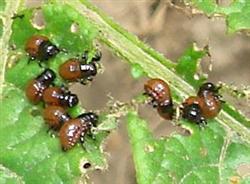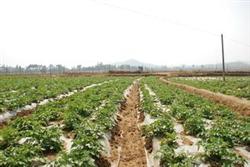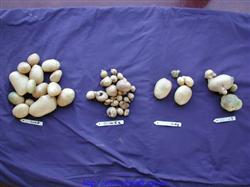Identification and Control of Potato Beetle

Potato beetle, also known as potato leaf beetle, is a kind of quarantine pest in China. This insect originally lived on wild Solanaceae plants in the eastern foothills of the Rocky Mountains in the western United States. Because artificially bred potatoes can provide good nutrition for this beetle, coupled with the development of potato cultivation and transportation all over the world, potato beetles have gradually become internationally recognized as an important quarantine object. In China, it was first found in Yili area in 1993, although it is still controlled in the local area, it is suitable to occur in a wide range of areas in the whole country. All localities should strengthen monitoring, early detection and strict prevention and control. The potato beetle is easy to identify. The adult is short oval and 9.0 to 11.5 mm long. The overall color is light yellow or yellowish brown. Each sheath has 5 black stripes longitudinally. There are more than a dozen black spots on the front chest dorsal plate, and the middle two are the largest. "U" or "V" shape. The larvae are dark brown to orange, with two rows of dark bone slices on each side, the abdomen is dilated and raised, and the 4th instar larvae are about 15 mm long. The egg mass is laid on the back of the leaf, long ovoid, yellowish or dark orange. Potato beetles produce 1-4 generations a year. A remarkable feature is that its adults have a long life span of up to 1 year on average, can survive the winter in the soil, endure hunger, and can migrate thousands of meters with the wind. It can also be hidden in seed potatoes, agricultural products, seeds, seedlings and packaging materials to spread over long distances by means of transport such as airplanes, ships, trains, cars and so on. Field surveys should be conducted on sunny days and not in the morning and evening. Another characteristic of the potato beetle is that it likes to eat important crops such as potatoes, tomatoes, eggplant and tobacco. Its adults and larvae eat potato leaves or tops, reproduce quickly, eat a lot of food, and often bite the leaves, or even eat them up. At present, the focus of the prevention and control of potato beetles is to strictly implement the transportation and quarantine procedures, strict control, and prevent the transfer of potato tubers and living plants from the epidemic areas. Other host plants and packaging materials of Solanaceae from the epidemic area shall be quarantined and disinfested according to the regulations. For the areas where potato beetles are suitable for growing, it is necessary to strengthen epidemic surveillance and improve the system. In the areas that have already occurred, comprehensive control measures should be implemented, including autumn and winter irrigation, non-Solanaceae vegetables, crop rotation, artificial killing and pesticide control. Chemical control uses chlorpyrifos (Lexben) and pyrethroids, such as 25% cyhalothrin (kung fu) 30g per mu, 20% fenvalerate (quick kill) 40g / mu, 2.5% deltamethrin (enemy kill) 20g / mu water spray. As potato beetles are easily resistant to organophosphorus and pyrethroids, fipronil (fipronil), acetamiprid, imidacloprid, and Bacillus thuringiensis preparations can be used alternately.
- Prev

Potato watering is fastidious
Potato in the growth process, which stage should be less watering, which stage should be more watering, which stage should not be watered, is very fastidious, let's talk about this issue. Potatoes from seedling arch soil to flowering, generally not watered, squatting seedlings, especially when the drought is watered. Cultivation experts in loam with good water retention.
- Next

Causes and Control measures of malformed Potato
Malformed potato is an important problem that some growers ignore while blindly increasing yield, that is, abnormal potato often appears in the process of tuber growth, especially in spring cultivation in the second season, because of high temperature and drought, the rate of deformed potato is high, which seriously affects the commerciality of potato and greatly reduces the horse bell.
Related
- Where is it suitable to grow horseradish in China? it is expected to see the middle altitude horseradish in Alishan.
- How to prevent tomato virus disease reasonably? (Control methods included)
- Many people like to plant towel gourd on the balcony. What are the main points of this method and management?
- What crops can chili peppers be mixed with?
- Fertilization techniques and matters needing attention in Tomato
- What are the grafting techniques for peach seedlings in spring?
- Harm and control methods of root swelling disease of Chinese cabbage
- What are the pests of sweet potatoes? How to prevent and cure it?
- Symptoms, causes and Control methods of navel Rot in Tomato
- The cause of "Cucumber rotten bibcock" in Farmers' planting Cucumber and its Control Plan

